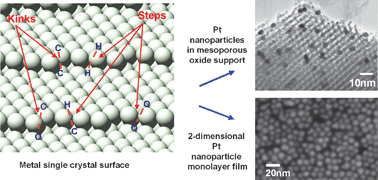Model systems for studying molecular surface chemistry have evolved from single crystal surfaces at low pressure to colloidal nanoparticles at high pressure. Low pressure surface structure studies of platinum single crystals using molecular beam surface scattering and low energy electron diffraction techniques probe the unique activity of defects, steps and kinks at the surface for dissociation reactions (H–H, C–H, C–C, O![[double bond, length as m-dash]](https://www.rsc.org/images/entities/char_e001.gif) O bonds). High-pressure investigations of platinum single crystals using sum frequency generation vibrational spectroscopy have revealed the presence and the nature of reaction intermediates. High pressure scanning tunneling microscopy of platinum single crystal surfaces showed adsorbate mobility during a catalytic reaction. Nanoparticle systems are used to determine the role of metal–oxide interfaces, site blocking and the role of surface structures in reactive surface chemistry. The size, shape and composition of nanoparticles play important roles in determining reaction activity and selectivity and is covered in this tutorial review.
O bonds). High-pressure investigations of platinum single crystals using sum frequency generation vibrational spectroscopy have revealed the presence and the nature of reaction intermediates. High pressure scanning tunneling microscopy of platinum single crystal surfaces showed adsorbate mobility during a catalytic reaction. Nanoparticle systems are used to determine the role of metal–oxide interfaces, site blocking and the role of surface structures in reactive surface chemistry. The size, shape and composition of nanoparticles play important roles in determining reaction activity and selectivity and is covered in this tutorial review.

You have access to this article
 Please wait while we load your content...
Something went wrong. Try again?
Please wait while we load your content...
Something went wrong. Try again?
![[double bond, length as m-dash]](https://www.rsc.org/images/entities/char_e001.gif) O bonds). High-pressure investigations of platinum single crystals using sum frequency generation
O bonds). High-pressure investigations of platinum single crystals using sum frequency generation 

 Please wait while we load your content...
Please wait while we load your content...